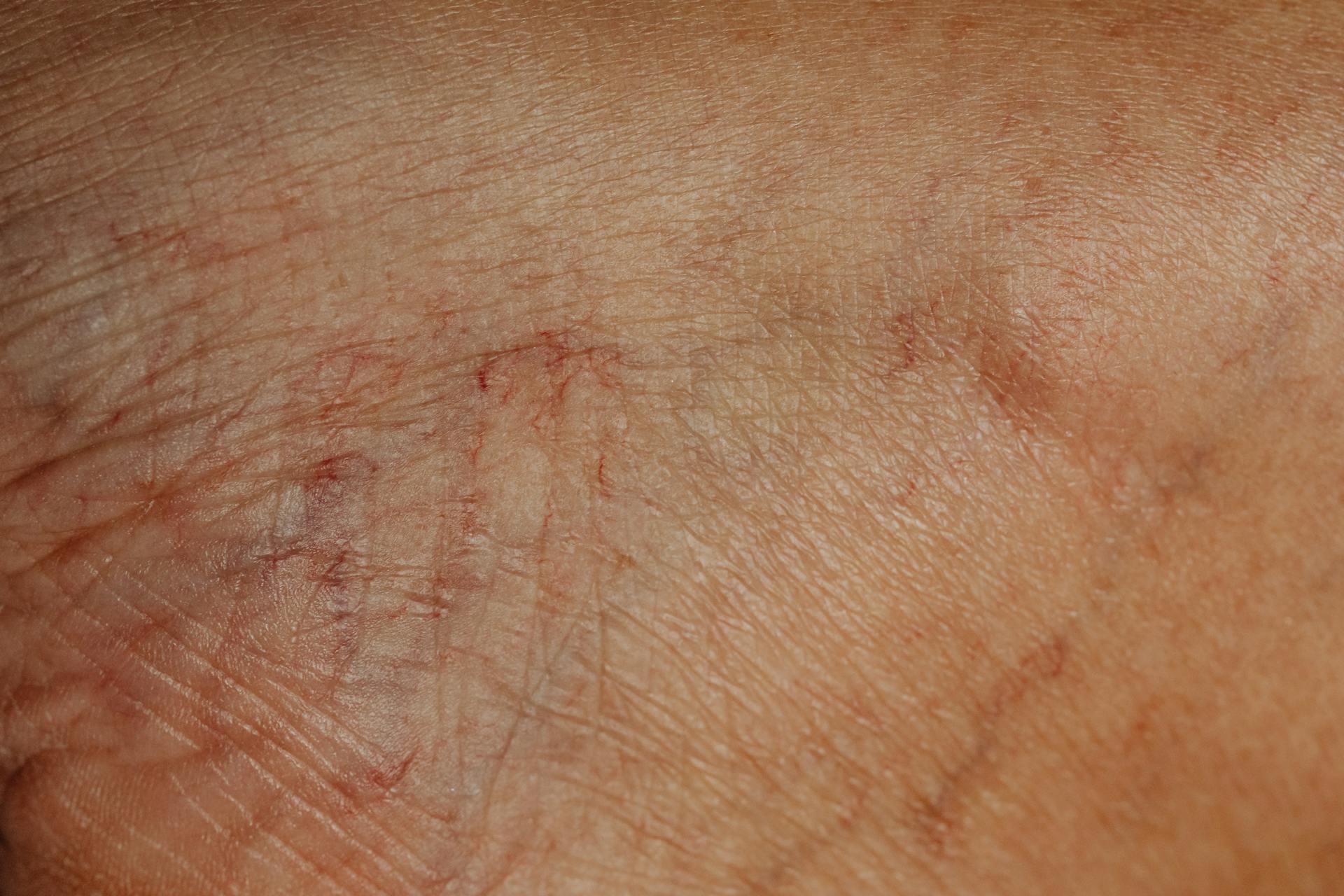
Cutaneous hemangiosarcoma in dogs is a rare and aggressive type of cancer that affects the skin.
This cancer is more common in older dogs, typically over the age of 10.
It's essential to catch this cancer early, as it can be challenging to treat once it has spread.
Cutaneous hemangiosarcoma often presents as a firm, red or purple nodule or mass on the skin.
If this caught your attention, see: Cutaneous Lymphoma Canine
What Is Hemangiosarcoma?
Hemangiosarcoma is an aggressive form of cancer that develops from blood vessels. It can occur anywhere in the body but most often affects a dog's spleen, heart, liver, or skin.
Hemangiosarcoma tumors are composed of abnormal blood and blood vessels that are fragile, invasive, and easily ruptured. This can lead to hemorrhaging into a body cavity, causing many of the clinical signs associated with hemangiosarcoma.
The disease typically affects middle-aged to older dogs, but it has also been reported in puppies as young as a few months old. Some breeds may be predisposed to hemangiosarcoma, including German Shepherds, Golden Retrievers, Labrador Retrievers, Boxers, and Pit Bulls.
For your interest: Dog Body Language with Other Dogs
Dogs with thin hair coats, such as Whippets, Greyhounds, Italian Greyhounds, Beagles, English Pointers, Dalmatians, and Basset Hounds, may also be at a higher risk.
Here are some of the most common types of hemangiosarcoma:
- Splenic: This type of cancer invades the spleen, an abdominal organ responsible for immune system function, red and white blood cell production, and storage of blood products.
- Cardiac: This cancer typically forms in the right atrium, one of the heart's chambers.
- Cutaneous/subcutaneous (skin): This cancer affects the skin (cutaneous or dermal) and under the skin (subcutaneous).
Causes and Symptoms
Cutaneous hemangiosarcoma in dogs can be a concerning diagnosis, and it's essential to understand the causes and symptoms to provide the best care for your furry friend.
Lumps or masses in the skin are a common symptom of cutaneous hemangiosarcoma, which can be detectable in the affected area.
Weight loss is another symptom that may appear, often accompanied by a general lack of energy and lameness.
Some breeds are predisposed to hemangiosarcoma, suggesting a possible genetic link.
Cutaneous hemangiosarcoma has been linked to UV exposure, especially in thin, light-coated dogs who spend extended periods outdoors.
Here are some possible symptoms of cutaneous hemangiosarcoma in dogs:
- Lump(s) detectable in the skin
- Black or red mass in the skin
- General lack of energy, lameness, and/or lack of engagement
Symptoms of Hemangiosarcoma
Hemangiosarcoma can be a challenging diagnosis for pet owners, but being aware of the symptoms can help you catch the issue early.
A lump or lumps in the abdomen is often the first sign of hemangiosarcoma.
You might notice a black or red mass in the skin, which can be a visible indication of the disease.
Weakness is a common symptom, and it's essential to pay attention to any changes in your dog's energy levels.
Heart arrhythmia can also be a symptom, and if you notice any irregular heartbeats, it's crucial to consult a veterinarian immediately.
Weight loss is another common symptom, and it's not just about the number on the scale – it's about your dog's overall health and well-being.
Partial or complete loss of movement can be a sign of hemangiosarcoma, so if you notice any changes in your dog's mobility, seek veterinary attention.
Seizures and/or intermittent collapsing can be a symptom, and if you witness either of these, it's essential to get your dog to a vet as soon as possible.
Pale mucous membranes are also a symptom, and if you notice any changes in your dog's gums or eyes, it's worth investigating further.
Here are some common symptoms of hemangiosarcoma in dogs:
- Lump(s) detectable in the abdomen
- Black or red mass in the skin
- Weakness
- Heart arrhythmia
- Weight loss
- Partial or complete loss of movement
- Seizures and/or intermittent collapsing
- General lack of energy, lameness, and/or lack of engagement
- Pale mucous membranes
Causes of Hemangiosarcoma
Hemangiosarcoma is a complex condition, and unfortunately, most of its causes are still unknown. One of the possible links is genetics, as certain breeds are more predisposed to the condition.
Skin hemangiosarcoma has been linked to UV exposure, especially in thin, light-coated dogs. This is a concern for dog owners who live in sunny areas or spend a lot of time outdoors with their pets.
In humans, chemicals, insecticides, toxins, and radiation have been associated with hemangiosarcoma development. It's likely that these factors also contribute to the condition in dogs, although more research is needed to confirm this.
Splenic hemangiosarcoma is a specific type of the condition, and its causes are still not well understood.
Diagnosis and Treatment
Diagnosis of cutaneous hemangiosarcoma in dogs typically begins with a veterinarian evaluating any skin mass larger than a pea (1 cm) and/or any that has been present for more than one month.
A veterinarian should aspirate some cells from the mass(es) to determine the type of growth. This is because no one can simply look at a skin mass and know what it is.
Explore further: Hemangiosarcoma Dog Skin Bleeding
A thorough patient history and complete physical examination will be recommended, which may include blood and urine tests, as well as some diagnostic imaging.
To confirm the diagnosis, a veterinarian will remove and biopsy the tumor.
Here is a list of some diagnostic tests that may be recommended:
- Complete blood count
- Serum biochemical profile
- Urinalysis
- Coagulation profile
- Chest radiography (x-rays)
- Abdominal radiography +/- sonography
- Echocardiography
Treatment for cutaneous hemangiosarcoma in dogs typically involves surgical removal of the tumor, which is the treatment of choice for most cases.
Additional reading: Canine Liver Cancer Treatment
Hemangiosarcoma Diagnosis
Diagnosing hemangiosarcoma requires a thorough approach, and here's what you need to know.
Any skin mass larger than a pea (1 cm) and/or any that has been present for more than one month should be evaluated by a veterinarian. A veterinarian should obtain a thorough patient history and perform a complete physical examination.
Patients with visceral hemangiosarcoma often don't have any clinical signs until a tumor ruptures to cause internal bleeding. Depending on the location and severity of the bleeding, patients may be depressed, refuse to walk or play, develop pale (or white) gums, have trouble breathing, collapse, and/or have a distended abdomen.
A veterinarian will recommend some initial tests, including a complete blood count, serum biochemical profile, urinalysis, coagulation profile, chest radiography (x-rays), abdominal radiography +/- sonography, and echocardiography.
Here are the initial tests a veterinarian may recommend:
- Complete blood count – a non-invasive blood test that measures red blood cells, white blood cells, and platelets
- Serum biochemical profile – a non-invasive blood test that assesses liver and kidney function, as well as electrolytes (i.e.: sodium and potassium) and certain gastrointestinal enzymes.
- Urinalysis – non-invasive urine test that helps to evaluate renal function and to screen for possible urinary tract inflammation and infection.
- Coagulation profile – a non-invasive blood test helps determine if a patient can properly form a proper blood clot
- Chest radiography (x-rays) – a non-invasive imaging test to screening for evidence of heart and lung changes, including metastasis (cancer spread)
- Abdominal radiography +/- sonography – non-invasive imaging of the abdomen can assess organ size and architecture, and identify tumors of internal organs
- Echocardiography – Sonographic examination of the heart can evaluate this organ’s function, identify tumors of the heart, and confirm the presence of abnormal fluid in the sac around the heart (called pericardial effusion) caused by a bleeding tumor
A definitive diagnosis of hemangiosarcoma is made by removal and biopsy of the tumor.
Treatment of Hemangiosarcoma
Surgical removal of the tumor is the treatment of choice for most hemangiosarcomas, especially for skin hemangiosarcoma and uncomplicated splenic hemangiosarcoma.
Surgery is not always a practical option for tumors that have spread or are on organs that cannot be removed, like the heart.
Chemotherapy and radiation therapy are often used in combination with surgery to extend the life expectancy of dogs with hemangiosarcoma.
Chemotherapy can slow the growth of tumors and is typically well-tolerated by dogs, as the doses of chemotherapy medications are different than those used in humans.
Neither chemotherapy nor radiation will cure dogs of hemangiosarcoma, but they can increase their quality of life after diagnosis.
For your interest: Canine Bone Cancer Life Expectancy
Other treatments may be used to help minimize side effects or complications of hemangiosarcoma, including:
- Anti-bleeding medications
- Procedures to remove fluid from around the heart, in the chest, or in the abdomen
- Bioactive extracts from mushrooms
- Anti-arrhythmic drugs
- Blood transfusions
The standard chemotherapy protocol for Hemangiosarcoma is single-agent and combination doxorubicin, given every 3 weeks.
Treatment Options
Surgical removal of the tumor is often the treatment of choice for cutaneous hemangiosarcoma in dogs. This is most effective for skin hemangiosarcoma and uncomplicated cases.
Chemotherapy is a common treatment for many forms of hemangiosarcoma, including cutaneous hemangiosarcoma. It can slow the growth of tumors and greatly extend a dog's life expectancy.
Radiation therapy is also used in conjunction with surgery or chemotherapy to help manage the disease. Unfortunately, neither chemotherapy nor radiation can cure cutaneous hemangiosarcoma, but they can improve a dog's quality of life.
To help minimize side effects and complications, your veterinarian may prescribe anti-bleeding medications or perform procedures to remove fluid from around the heart or in the chest or abdomen.
Some dogs may also benefit from bioactive extracts from mushrooms, anti-arrhythmic drugs, or blood transfusions to manage specific symptoms or complications.
Here are some common treatments used to manage cutaneous hemangiosarcoma:
- Anti-bleeding medications
- Procedures to remove fluid from around the heart, in the chest, or in the abdomen
- Bioactive extracts from mushrooms
- Anti-arrhythmic drugs
- Blood transfusions
Frequently Asked Questions
What is the life expectancy of a dog with a cutaneous hemangiosarcoma?
Life expectancy for dogs with cutaneous hemangiosarcoma is typically short, ranging from weeks to a few months. However, some cases may have a slightly longer survival time, making treatment and care a crucial consideration
What are the symptoms of a hemangiosarcoma in the skin?
Symptoms of skin hemangiosarcoma include excessive bruising, pain, weakness, and reluctance to stand or walk. Pale gums and collapse can also occur if the tumor bleeds into surrounding tissues
Can hemangiosarcoma in dogs be cured?
For dogs with hemangiosarcoma confined to the dermis and no metastasis, surgical treatment can be curative. However, the prognosis varies depending on the stage and location of the cancer.
Can dermal hemangiosarcoma spread?
Yes, dermal hemangiosarcoma can spread quickly if not treated promptly, which is why surgical removal is often recommended as soon as possible.
Sources
- https://wagwalking.com/condition/hemangiosarcoma
- https://vecc24.com/hemangiosarcoma-dogs-aggressive-blood-vessel-cancer/
- https://www.petmd.com/dog/conditions/cancer/hemangiosarcoma-dogs
- https://www.ethosvet.com/blog-post/hemangiosarcoma-in-dogs-2/
- https://wearethecure.org/learn-more-about-canine-cancer/canine-cancer-library/hemangiosarcoma/
Featured Images: pexels.com


